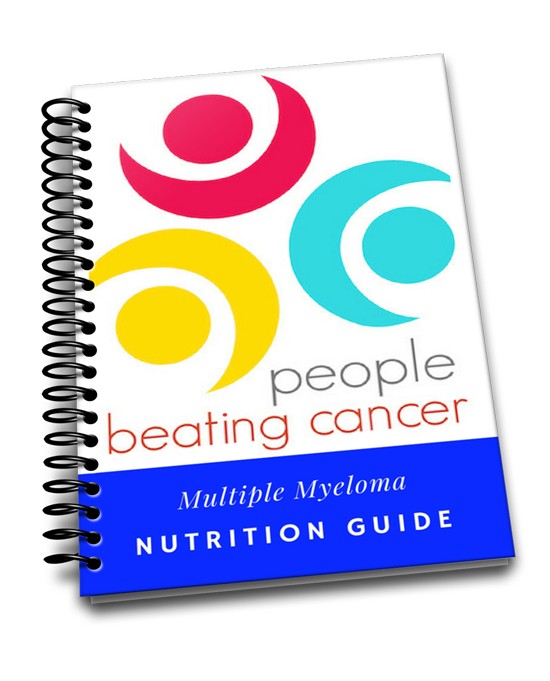
Recently Diagnosed or Relapsed? Stop Looking For a Miracle Cure, and Use Evidence-Based Therapies To Enhance Your Treatment and Prolong Your Remission
Multiple Myeloma an incurable disease, but I have spent the last 25 years in remission using a blend of conventional oncology and evidence-based nutrition, supplementation, and lifestyle therapies from peer-reviewed studies that your oncologist probably hasn't told you about.
Click the orange button to the right to learn more about what you can start doing today.
- You are here:
- Home »
- Blog »
- Healthy Living Products »
- Secondary Cancer – Multiple Myeloma
Secondary Cancer – Multiple Myeloma

“Pediatric and AYA cancer survivors remain at increased risk for treatment-related subsequent neoplasms, even after the age of 40, according to a new study published online ahead of print in the Journal of Clinical Oncology”
I live with an increasing risk of secondary cancer. Technically I’m an AYA cancer survivor. I was diagnosed with multiple myeloma at the age of 34. But let’s face it, I am an adult MM survivor. The vast majority of MM survivors are over the age of 40.
The issue is not about being a young cancer patient, I think the issue is about living for 20.30,40 plus years beyond high-dose, aggressive therapies and the long-term and late stage side effects of toxic therapies.
If my math is correct (I am working on healing my chemobrain…) the risk of a secondary cancer diagnosis after 30 years as a MM survivor is over 25 percent…annually.
There is an increased risk of non-melanoma skin cancer of more than 13%?!?
It has been over 25 years since I had my autologous stem cell transplant (12/95). The question that runs around my brain 24/7 is whether or not any of my nutritional supplements that I take daily. Or to put it a different way, why haven’t I gotten a treatment-related secondary cancer?
I would like to think my anti-cancer nutrition, supplementation, and lifestyle all help.
Keep in mind that the study is only highlighting the risk of secondary, treatment related cancers. I live with a host of long-term and late-stage side effects such as heart damage, nerve damage, cognitive disfunction and more.
To Learn More About Chemotherapy-induced Side Effects- click now
To learn more about evidence-based therapies to reduce the risk of cancer and side-effects such as a secondary cancer, please scroll down the page, post a question or comment and I will reply ASAP.
Thank you,
- MM Survivor
- MM Cancer Coach
- Director PeopleBeatingCancer
Recommended Reading:
Childhood cancer survivors at risk for subsequent neoplasms later in life
“Survivors of childhood cancer remain at increased risk for treatment-related subsequent neoplasms (secondary cancer), even after the age of 40, according to a new study published online ahead of print in the Journal of Clinical Oncology…
High Risk of Second Cancers After Hodgkin’s Lymphoma
“Now a study from the same group published December 24 in the New England Journal of Medicine reports a cumulative incidence of a secondary cancer is 48.5% after 40 years of surviving Hodgkin’s lymphoma…”
Recommended Reading:
- Cancer Coaching Testimonials- PeopleBeatingCancer
- Late Effect- Cardiomyopathy from Chemotherapy
- Chemotherapy Side Effect- Hemorrhagic Cystitis and Bladder Cancer
“The relative risk of developing a solid subsequent malignant neoplasm (sSMN) (secondary cancer) remained elevated in survivors of childhood Hodgkin lymphoma, according to extended follow-up of more than 25 years from the Late Effects Study Group (LESG) cohort published in Cancer…
Patients were separated into 3 groups based on the therapy they had received as part of their primary lymphoma treatment or as salvage therapy for disease recurrence:
- radiotherapy (RT) alone,
- chemotherapy alone, or
- radiotherapy and chemotherapy…
The relative risk of developing an sSMN was estimated with proportional subdistribution hazards regression, which used death as a competing risk and calendar time as the time scale. Explanatory variables, such as age at the time of diagnosis of Hodgkin lymphoma (0-9 years versus 10-16 years); sex; doxorubicin exposure; alkylating agent score (≥2 or <2); and localized radiotherapy to the chest, abdomen or pelvis, or neck, were assessed for their impact on developing an sSMN without statistical selection.
The analysis accounted for 1136 patients who were diagnosed with Hodgkin lymphoma between 1955 and 1986. The median age at the time of diagnosis for these patients was 11 years (range, birth–16 years) with 23,212 person-years of follow-up from the time of primary diagnosis. Sensitivity analyses were done to account for the 595 patients who had not experienced an event (sSMN or death).
A total of 162 patients developed a collective total of 196 sSMNs, which included breast cancer, thyroid cancer, colorectal cancer (CRC), lung cancer, basal cell carcinoma (BCC), or other/unspecified, resulting in a 26.4% cumulative incidence of any sSMN at 40 years after primary diagnosis. This translated to a 14-fold increase in the risk of developing an sSMN compared with the general population. Although BCC was identified as an sSMN, it was excluded from further analysis because it was not reported to the Surveillance, Epidemiology, and End Results Program database. By age 50 years, the cumulative incidence of breast cancer, lung cancer, colorectal cancer, and thyroid cancer was 45.3%, 4.2%, 9.5%, and 17.3%, respectively, among those at highest risk.
Across all cohorts, a multivariable analysis indicated an increased risk of sSMN (secondary cancer) among females (HR, 1.8; 95% CI, 1.3-2.5) and those who received radiotherapy (HR, 4.8; 95% CI, 1.8-19.7).
“These findings support the need for continued surveillance of patients with Hodgkin lymphoma, regardless of the era in which they were treated,” wrote study investigators.
Of the 54 individuals who developed breast cancer, 42 were women. The median age at the time of their primary and subsequent diagnoses were 13 years (range, 6-15) and 37 years (range, 24-48), respectively, resulting in a median age of 25 years (range, 10-40 years) between diagnoses. Of the 42 women, 9 developed contralateral breast cancer after a median of 5.9 years (range, 1.6-10.5).
Overall, these patients had a 25.8-fold increased risk of developing breast cancer compared with the general population (95% CI, 19.3-fold–33.5-fold; P <.001). Patients who had been diagnosed with Hodgkin lymphoma between the ages of 10 and 16 were approximately 5 times as likely to develop a breast sSMN than patients <10 years relative to the general population (P = .004). However, exposure to a high-dose alkylating agent lowered the risk of developing breast cancer (HR, 0.5; 95% CI, 0.3-0.9).
After a median of 28 years following primary diagnosis (range, 12-34), 11 cases of subsequent lung cancer were reported; 10 patients were male, although all had received chest RT. The median age at the time of lung cancer diagnosis was 41 years (range, 22-46). Although the cumulative incidence of lung cancer was 2.3% by age 50, males were at a 26.7-fold increased risk of developing lung cancer compared with the general population (95% CI, 13.4-fold–16.7-fold). Further, those who had been treated with RT <10 years of age were at an increased risk of developing lung cancer. Conversely, females were at a 3.3-fold increase risk of developing lung cancer relative to the general population (95% CI, 0.2-fold–14.6-fold).
CRC was also identified in 15 patients after a median of 25 years (range, 15-45) after an initial diagnosis of Hodgkin lymphoma…
Contrary to the subset of women who went on to develop breast cancer, a multivariable analysis revealed that exposure to high-dose alkylating agents was found to be a risk factor associated with subsequent CRC development (HR, 5.1; 95% CI, 1.3-33.6). Moreover, abdominal/pelvic RT was found to be another independent risk factor (HR, 3.6; 95% CI, 1.1-16.1)…
The median age at the time of subsequent diagnosis was 34.5 years (range, 13-53 years). Compared with the general population, these patients harbored a 27.7-fold increase in the risk of developing thyroid cancer compared with the general population
Treatment with neck RT <10 years compounded this risk.
The risk of secondary malignancy among childhood survivors of Hodgkin lymphoma has long been established, but the investigators wrote that this study confirmed the continual risk of future malignancy beyond 25 years after a diagnosis of Hodgkin lymphoma, underscoring the need for appropriate screening techniques for those individuals at highest risk.


